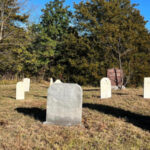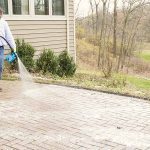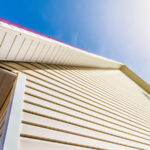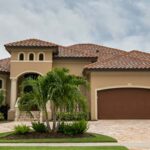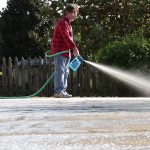Artificial Turf, Rugs, and Maintenance Tips
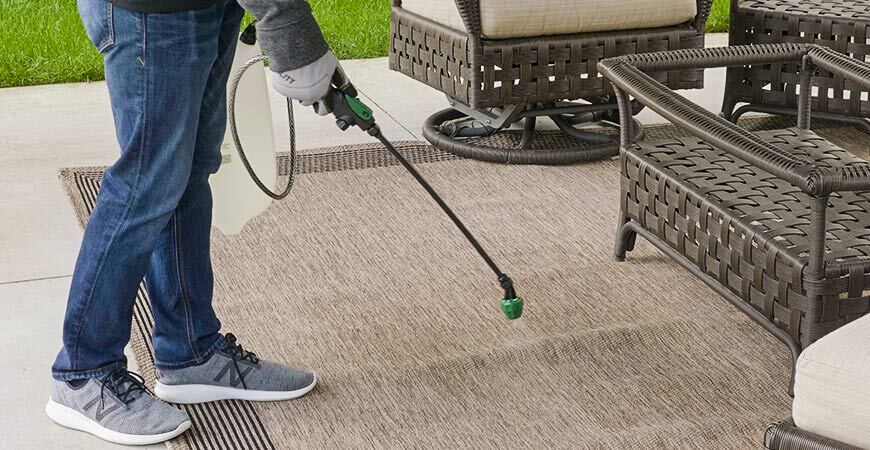
Starting to notice green and black stains on your outdoor artificial turf or rug? Learn how to remove moss, mold, mildew, and algae stains easily and effectively with these helpful tips.
See how the Wet & Forget Outdoor Concentrate can help remove those stains.
What are the benefits of artificial turf?
When it comes to artificial grass, it can last anywhere from 15 to 25 years.
Several benefits of artificial grass include minimized pooling of water and thus fewer mosquitoes, no more mowing, and a great-looking yard year-round.
What are the different uses for it?
From residential yards to golf courses, artificial grass can be installed in a variety of places. The most popular are residential, commercial, and recreational areas.
Residents can install it in their entire yard or in a more concentrated area. Commercial building properties can install artificial turf outside to minimize lawn care routines.
This is great for companies who want to provide an outdoor space for employees or customers without the hassle of lawn maintenance. Whether it’s golf courses, pool surroundings, or parks, turf can be found in many recreational areas.
Artificial turf is a good option to use in an area with high foot traffic or where water pools easily. Not only can turf drain water better than regular grass, but it helps reduce the amount of maintenance needed.

Are there different types of turf?
There are several alternatives to fit your lifestyle or appeal standards. The three main types of turf include polypropylene, polyethylene, and nylon.
Polypropylene turf is most commonly used on residential or company-building properties. They are the least expensive option due to them not being as durable as the other options, as they have a lower heat resistance level.
The blades can easily deform and lose their appeal over time. Polypropylene turf is commonly used for putting greens because it is lightweight and flexible.
Polyethylene turf differs from polypropylene in that it looks more natural and is more durable. It is greener in color and has a softer feel to it than polypropylene.
This is a popular choice for homeowners looking to replace their natural grass because it requires less maintenance. Typically, you will see this type of turf on athletic fields due to its durability and easy maintenance.
Nylon turf is the most durable and the least common of the three. This option is the most expensive option since it has the ability to withstand higher temperatures.
People opt for nylon turf to keep the blades of the grass standing up. However, they can quickly flatten and harden up due to nylon’s absorbency configuration.
What is infill, and what is the purpose of having it?
Infill helps not only weigh down the turf but also adds ballast to heavy foot traffic and helps with the backing system. By weighing down your artificial lawn, it helps it stay in place.
With ballast, it helps not only make your lawn look “fluffed” but also helps keep the blades standing up. It is crucial to get infill to ensure your artificial turf stays in tip-top shape.
Why would moss, mold, mildew, and algae grow on artificial turf?
Since artificial turf has perforations on the back, it allows for better drainage than natural lawns to help guide the flow of water. One way to help minimize organic growth is to not install your artificial lawn on concrete.
If installed on concrete, it does not offer the proper drainage support and can form pools of water. Minimizing pools of water on your lawn is critical to prevent organic growth feeding grounds because of moisture accumulation.
Are there ways to prevent organic growth on turf?
When installing your synthetic lawn, make sure it is installed correctly. Having proper installation helps with drainage- such as installing the turf on top of a layer of soil. If that is not an option for you, make sure to install drainage tiles to help with water drainage.
How do I maintain and clean my artificial turf?
There are several ways to upkeep your green space. Clearing debris, rinsing the lawn, brushing it out, and spraying it with Wet & Forget are simple ways to upkeep your turf. Wet & Forget will clean up any moss, mold, mildew or algae stains on your artificial turf.
Ensure that the turf is completely dry before applying the product. For smaller surfaces of turf, use our Wet & Forget Concentrate. For larger areas, use our Wet & Forget Xtreme Reach™ Hose End.
What kind of outdoor rugs are there?
Whether it’s an eye-catching printed rug or a more earthy rug, the two main types of outdoor rugs are natural and synthetic. These two are the most common due to its ability to withstand the outdoors.
What are the characteristics of a natural vs. synthetic outdoor rug?
Knowing the character of the type of outdoor rug you are about to buy can be very helpful in determining the best cleaning routine for them. It can also help you figure out what kind of outdoor rug may be the best option for you.

Natural rugs create an earthy and inviting energy. They are best in areas where the climate does not fluctuate as much.
One thing to keep in mind is that they are more absorbent because of the plant’s fibers. This absorbent composition makes them more susceptible to moss, mold, mildew, and algae.
But if a natural rug is what appeals to you more, just make sure you check them frequently for organic growth. Materials used for natural rugs include sisal, hemp, jute, and seagrass.
Synthetic rugs create a bright summer party energy and are more receptive to climate fluctuations. Synthetic rugs tend to be lower maintenance than natural rugs due to their ability to dry quickly after coming into contact with moisture.
This makes them less prone to moss, mold, mildew, and algae. Materials used for synthetic rugs include acrylic, nylon, polyester, and polypropylene.

How can I prevent mold, moss, mildew, and algae growth?
First and foremost is to check frequently for moss, mold, mildew, and algae growth, so you can treat it at first sight. If possible, store away rugs before forecasted rainfall to limit the amount of water your rugs come into contact with- especially when it comes to natural rugs.
Proper storage during the off-season will help with preventing organic growth. When preparing your rug for storage, make sure to clean off any debris and ensure that it is completely dry.
Instead of wrapping your rug up in plastic, try wrapping it with a cotton or muslin sheet and storing it in a polyurethane wrap. By doing so, you limit moisture and bugs from coming into contact with your rug and damaging it.
Find a location to stow away your rug that does not have a damp environment, as organic growth can cultivate here. For more information on storing rugs click here.
How to clean natural and synthetic outdoor rugs?
Make sure that you clean spills as soon as they occur. Prevent moisture from basking in the material of the rug by removing stains.
If organic growth is spotted, treat them with the Wet & Forget Outdoor Concentrate or Wet & Forget Ready to Use products to remove them.
Wet & Forget Outdoor Concentrate Instructions:
- Check that the surface is completely dry before applying the product.
- Mix the concentrate with 5-parts water and 1-part concentrate (20 ounces) in a pump-up garden sprayer.
- Spray the area affected by organic growth.
- Let it dry for 4 to 5 hours and let nature do the rest.
For smaller, more concentrated areas, try the Wet & Forget Outdoor Ready to Use:
- Check that the surface is completely dry before applying the product.
- Detach the trigger sprayer and stretch out the 3ft tube.
- Remove and open the flip cap and firmly insert the hose tip.
- Spray the area affected by organic growth.
- Let it dry for 4 to 5 hours and let nature do the rest.
Remove moss, mold, mildew, and algae stains from your turf and outdoor rugs with the Wet & Forget Outdoor Concentrate or the Wet & Forget Outdoor Ready-To-Use products.
If you clean your surfaces using Wet & Forget products properly, the chances of regrowth occurring will be reduced. Based on customer feedback, regrowth is typically not observed for up to a year, and customers in the Midwest and Northeast regions report not seeing regrowth for 2 to 3 years.
Check out our store locator for more information on where to find Wet & Forget products near you. To answer any of your questions, visit our FAQ.

